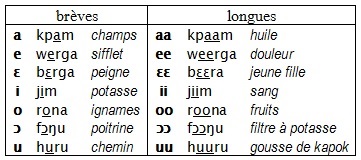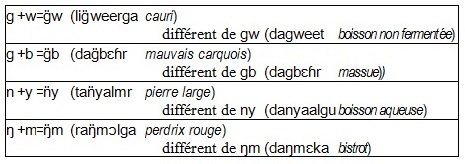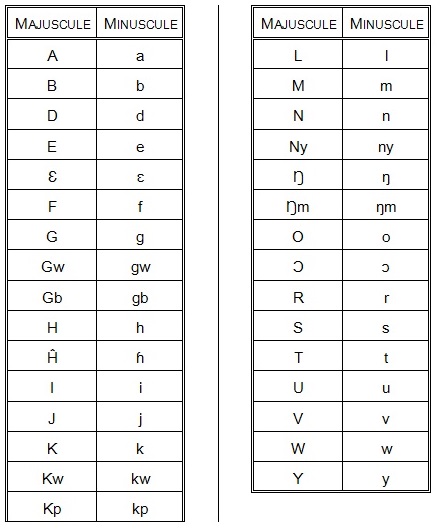Orthography
The orthography of a language includes the guidelines for writing the words. For practicality it is suggested that there is one symbol (or a unique combination of symbols) to represent each distinctive sound occurring in the language; thus, this involves a one-to-one correspondence with no additional symbols for the same sounds. The one to one nature of the orthographic system results in contrastive pairs for words which differ by one letter representing one sound. We call these minimal pairs; these are used to prove the set of existing sounds.
Thus, in Nawdm, d and r contrast in certain words:
daaga.............. male
raaga............... small forest
Nevertheless, in Nawdm, certain sounds are symbolized by two-letter combinations. These are:
gb, gw, kp, kw, ny, ŋm.
In the Nawdm orthograpy, there are several sounds that do not exist in French, showing proof that Nawdm is in fact different from French. Note, these consonants do not exist in French, but do in Nawdm: gb, gw, kp, kw, ɦ, ŋ, ŋm. (Note that for English, the sounds made by gw, kw, ɦ, ŋ do exist, but they are represented by other letter combinations, except for h.)
1. Vowels
1.1. Summary of Vowels
In Nawdm, there are 7 vowels : a, e, ɛ, i, o, ɔ, u. These are practically the same sound as in French, but some are written more phonetically in Nawdm. The vowel "ɛ" in Nawdm corresponds to "è" in French. The vowel "e" in Nawdm corresponds to "é" in French1. We have decided to never mark tone or accent for "e" in Nawdm.
The vowel "o" is pronounced like the "o" in French words such as « dos (back)», « tôt (porridge)»2.
The vowel "ɔ" is also identical to open "o" in French words such as « porc (pork)», « sorte (type)».
The vowel "u" in Nawdm corresponds to the French ou".
1.2. Long vowels
When you hear an extended vowel in pronouncing a word in Nawdm, it is written as a double vowel. This is known as lenthened vowels. Every vowel in Nawdm can be lengthened, or doubled.
2. Consonants
There are 24 consonants in Nawdm: b, d, f, g, gw, gb, h, ɦ, j, k, kw, kp, l, m, n, ny, ŋ, ŋm, r, s, t, v, w, y.
Certain consonants, such as b, d, f, r, t are nearly identical to those in French, while others, such as: g, gb, gw, h, j, k, kp, kw, m, n, ny, ŋ, ŋm, v are specific to Nawdm.
A special consonant in Nawdm is the ɦ which is distinct from French and consists of an abrupt break in air flow, giving the impression that the vowel becomes stronger or more clear. The ɦ is a veritable consonant that occurs at the beginning, middle, or end of a word.
ɦafaaŋu ............ pork
kuɦdga ............. the screen
jaɦ ................... a little
3. Vocalic release
Vocalic release in Nawdm is the sound of a short additional vowel pronounced within words or at the end of words. It occurs only in verbs, nouns, and pronouns, but is not written.
Kad ! ................ Sit ! (We hear a short e after the d)
tab ................... the ark (We hear a short e after the b)
Lˋ diɦn. .............. It is finished. (We may hear a short e after the l and will hear a short i between the ɦ and the n)
Remember that this release feature only occurs with consonants.
4. Tone
Tone in Nawdm has functionality in written as well as in spoken form. There are two distinct tones in Nawdm: high tone marked with the acute accent (ˊ) and low tone maked with a grave accent (`). Tone has a high grammatical function in this language, distinguishing verbal aspect and also for rendering a phrase correct. For example:
Ĥà daan weem. .................. He came early.
Ĥá daan weem ! ................. May he come early.
With tone marking, we can distinguish one word from another. For example:
fíígú. ................ the braid
fììgú. ................ the rock
In the orthography, only the pronouns are written with tone marks; these markings on the pronoun enables us to determine the tonality of the entire phrase.
In the dictionary, all the tone markings within brackets after the word enable the reader to correctly pronounce the words.
5. Les letters of the Nawdm alphabet
The letters of the Nawdm alphabet are displayed in the columns in the second chart below. The letters are listed in alphabetical order, showing both upper and lower case letters. In addition, in order to show the difference between two consecutive consonants of a word and one consonant sound represented by two letters, the first consonant of a combination is marked with a trema. In the small chart below, the words that include consonant combinations are marked with a trema on the first consonant. These words are followed by their counterparts which include distinct consecutive consonants:
6. Standardization de the orthography and variable pronunciation
The letters just described are those that are used to write words in Nawdm. These letters, or orthographic symbols, represent phonemes. The orthography of the words is based essentially on the phonology of Nawdm, except for a couple of adjustments due to morphology features of this language. Thus, a morpheme or a phoneme can be pronounced differently depending on its position in the word (beginning, middle, or end), or vary the pronunciation according to the dialects. This phenomena creates great difficulties in the standardization of the orthography of words. Nevertheless, we feel obligated to add the following standardization rule: every one letter or two-letter combination is retained in the orthography which each reader of each dialect needs for pronouncing their phonemes.
Thus "kw" is pronounced [kɥ] in Ténéga, [k] in Baga, Koka and Niamtougou, [f] in Siou and Banaa. For example kwiɦr ten is pronounced [kɥiɦr] in Ténéga; [kiɦr] in Baga, Koka and Niamtougou; [fiɦr] in Siou, Banaa.
"gw" is pronounced [gɥ] in Ténéga, [g] in Koka, Baga and Niamtougou, [b] in Siou and [gb] in Banaa. For example gwiɦiim sand is pronounced [gɥíɦiim] in Ténéga; [giɦiim] in Koka, Baga and Niamtougou; [biɦiim] in Siou; [gbiɦiim] in Banaa.
"g" initial is pronounced [j] in Ténéga, Siou and Banaa while in Koka, Baga and Niamtougou it is pronounced [g]. For example gaaga ebony tree is pronounced [jaaga] in Ténéga, Siou and Banaa; [gaaga] in Koka, Baga and Niamtougou.
"ŋm" is pronounced [ŋm] in Koka, Baga, Ténéga and Banaa, while in Niamtougou and Siou it is pronounced [m]. For example ŋmɛnga bird is pronounced [ŋmɛnga] in Koka, Baga, Ténéga and Banaa; [mɛnga] in Niamtougou and Siou.
"v" is pronounced [v] in Koka and Niamtougou, while all other places it is pronounced [b]. For example vooga calyx of kapok tree is pronounced [vooga] in Koka and Niamtougou; [booga] in Baga, Ténéga, Siou and Banaa.
"dr" is pronounced [rr] in Siou, and sometimes also in Ténéga and Banaa, while in Koka, Baga and Niamtougou it is pronounced [dr]. For example kpadr palm nut is pronounced [kparr] in Siou (Ténéga and Banaa); [kpadr] in Koka, Baga and Niamtougou.
7. The orthography of compound words
In Nawdm there are two kinds of compound words.
1. It is possible to form compound words with two or more root words, but only one class suffix is needed. The compound word is written as one word.
baŋkpaam ....... the red oil
In the Nawdm word above, there are two root words baŋ- palm tree, and kpaa- oil, with the class suffix –m.
2. There are also compound words in Nawdm comprised of two root words of which the first one can occur independently. In this case, we write the words separately.
Nyamtgu tia ................ someone from Niamtougou
saamaa laŋkpadga ........ the pineapples
All the compound words that have an independent root word are written separately, even if they are defined by one word in French.
8. Punctuation marks
Nawdm, in general, uses most of the same punctuation marks as in French. However, there is a difference for questions and exclamations. Nawdm uses two question marks in each sentence, one inverted at the beginning and the other at the end, as opposed to one in French. See the example below:
¿ Ĥà ɦɛna bee ? ........... What is he doing ?
Also note that Nawdm may use another punctuation mark following a question mark when the sentence continues. See the following example:
Ĥá gbaam-wu na ¿ fɔg̈wii ba tee ?, n gɛt ka ked. ... He asked him: where is this woman? And he continues on his journey.
The exclamation point is used in two cases in Nawdm: at the end of an imperative phrase and after interjections.
Ked haaga ! ................. Go home!
Hai ! Mà sa ! ................ Pardon, my father!
9. The hyphen
The hyphen has a special use in Nawdm and is used in two cases:
1. Between a verb and an (or several) object pronoun:
Bà sira-ma diit. .......... They served me food.
Bà sira-ma-t. ............. They served it to me.
2. In the plural imperative:
Jum-n ! ..................... You (plural) eat!
Tn jum-n ! ................ Let us eat!
[1] In the Siou dialect, the vowel written as e is more closed and relaxed, and corresponds to the vowel [ɪ] of the International Phonetic Alphabet.
[2] In the Siou dialect, the vowel transcribed o is more closed and relaxed, and corresponds to the vowel [ʊ] of the International Phonetic Alphabet.



